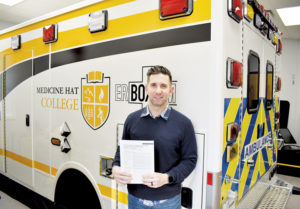MHC paramedic lead published in academic journal
By JEREMY APPEL on January 7, 2020.
SUBMITTED PHOTO
Medicine Hat College paramedic program co-ordinator Scott Mullin has had his master's thesis on chest compressions published in an academic journal. Its simulation research was conducted by MHC paramedic students.
jappel@medicinehatnews.com
The co-ordinator of Medicine Hat College’s paramedic program is now a published author in a peer-reviewed academic journal.
Scott Mullin had his master’s thesis, “The Effect of Operator Position on the Quality of Chest Compressions Delivered in a Simulated Ambulance,” published online by Cambridge University Press on Dec. 9, with a physical copy to come in the Prehospital and Disaster Medicine journal soon.
Mullin says the first step was to apply to the journal’s editors to see if they thought it suitable for their readership.
“It’s a big step from submitting a thesis in your master’s degree to publication, so a lot of it needed to be re-worked, re-worded a little bit so that it could be valid for publication,” he told the News.
Mullin’s professors – Sinéad Lydon and Paul O’Connor, who are listed as co-authors on the paper – were the ones who initially proposed he submit his thesis for publication, providing him with assistance in refining it.
The next step is peer review, where other people in medicine edit the paper to determine the validity of its conclusion and scientific methodology.
Mullin got his master’s at the National University of Ireland, which had an extensive online program he could do while working full-time at the college.
“There’s minimal master’s programs out there for healthcare simulation and this university came up as one of them,” he said. “That’s what got my interest, because there’s none in Canada.”
He says what he learned in the program assisted him “daily” at the college.
As for the content of his thesis, Mullin said he initially wanted to write about CPR, but that was too broad a topic, so he narrowed it down to the chest compression aspect of it, which is the biggest risk factor for paramedics when they’re transporting a patient.
“I had to do something in simulation and something that I thought was specific to paramedicine. I had this interest in patient care and safety for the paramedics in the back of an ambulance, because it’s a risky environment,” said Mullin.
The research was all done at MHC, with the participation of 24 paramedic student volunteers who tested two positions of chest compression – standing versus sitting and restrained by wearing a lap belt.
Its conclusion was that standing is preferable to seated, which puts the paramedic at heightened risk in a moving ambulance
He says a major benefit of getting his work published is the message it sends to students in the program – that they can contribute to research in their field. .
The research itself contributes to an understanding of paramedic and patient safety, Mullin added.
“We should not be risking our own safety to provide patient care in the back of an ambulance, and to push and promote other ways to enable other ways to do that care back there safely, but also to contribute to the best care for the patient,” he said.
18
-17
 SUBMITTED PHOTO
SUBMITTED PHOTO 

